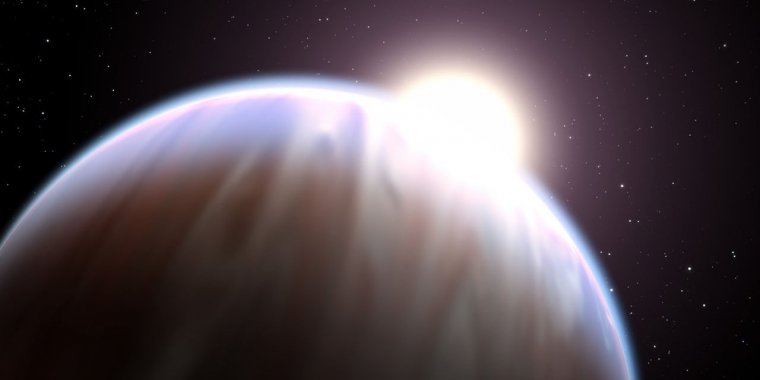| News / Space News |
Astronomers report dwarf star with unexpectedly giant planet
An international team of astronomers discovered an exoplanet, called NGTS-1b, revolving around M-dwarf star NGTS-1, that the team said does not fit existing notions of how stars and planets form. NGTS-1b is a gas giant, similar to Jupiter and of comparable volume and mass, but its parent star is about half the diameter and mass of the Sun, making this the most massive planet orbiting an M-dwarf ever discovered.

HD 189733 has a Jupiter-class planet. This image is artwork. ![]()
NGTS-1b, about 600 light years from the Earth, is so extremely close to its star that a revolution around its star takes only about 2.6 Earth days — 2.647298 ± 0.000020 — and its surface temperature is about 800 K.
The planet was discovered by observing periodic fluctuations in the star's apparent brightness as NGTS-1b passed in front of it. NGTS-1b's mass is less than Jupiter, about 0.812 MJ (mass of Jupiter), but it has greater volume, with radius about 1.33 RJ (radius of Jupiter).
The existing understanding of planetary formation, the team explained, says small stars can produce rocky planets but cannot not pull in enough mass for larger, gaseous ones like NGTS-1b.
Based on the observations, NGTS-1's radius is 0.573±0.077 R☉ (solar radius) and using that value, astronomers calculated its weight to be about 0.598 M☉ (solar mass).
The research team discovered NGTS-1b using the Next-Generation Transit Survey (NGTS), an array of telescopes physically located in Chile, which was designed to search for planets around bright stars. NGTS-1 is a relatively dim red M-dwarf, which are very common in the universe, of apparent magnitude 15.52 ± 0.08.
NGTS-1b was difficult to find, despite being a monster of a planet, because its parent star is small and faint. Small stars are actually the most common in the universe, so it is possible there are many of these giant planets waiting to found.
To date, scientists have discovered only three gas giants which revolves around M-dwarf stars. The other two are Kepler-45b and HATS-6b which have masses 0.505 MJ and 0.32 MJ respectively. (Wikinews)
YOU MAY ALSO LIKE

